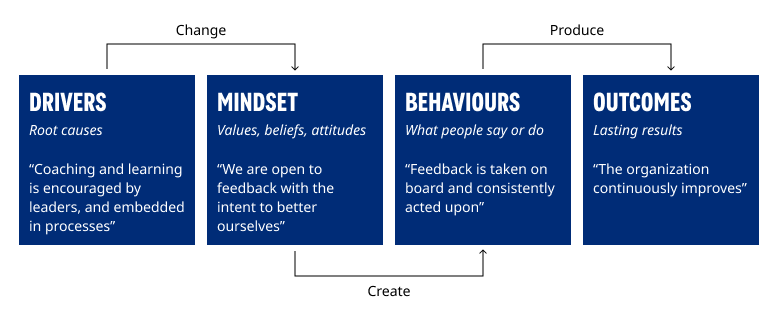Gross domestic product in the European Union sustained high growth during the last 10 years, driven largely by globalization, advancing urbanization, and increased consumption by wealthier segments of the population. The next decade will be dramatically different as geopolitical tensions rise and inflation, combined with demographic changes, slow economic growth. Companies must adapt to changing markets and more intense competition. To win in this environment they will need to focus more on traditional strategies such as product and service innovation and cost efficiency.
Cost Excellence means transformed operating model and cultural change
Achieving cost excellence must be a pillar of any business strategy to thrive in this new environment. Cost excellence focuses on transforming company performance for the long term, not simply pursuing tactics that have limited and short-term impact. It requires a fundamental rethinking of a company’s operating model, as well as a shift in its culture so that the workforce is engaged and motivated to adopt new, winning behaviors, to make the transformation sustainable.
Rethink how you operate your business
In most industries, businesses must incrementally increase efficiency by 2-3% just to keep pace. The ambition for cost excellence is much higher, setting double-digit ambitions to widen the gap with competitors. But building this new foundation is not easy. Everything from the customer proposition and the company’s capabilities to organizational set up and resources along the value chain need to be examined. Things to consider, include:
- What products, features, and service levels are really valued by the customer?
- Which parts of the operating model can be standardized to obtain synergies and scale while delivering value propositions that delight customers?
- What are the core strengths of the supply chain, the potential scale effects, and what is better sourced externally?
- How could the IT backbone and core processes be simplified, and duplications eliminated, only allowing for differentiation where it adds real value to customers?
- How can you redesign the operating model to create end-to-end accountability and financial transparency?
In essence, cost excellence operating models focus on adding value, simplicity, standardization, transparency, and accountability. The benefits go far beyond cost – they include better quality, reduced time to market, higher employee satisfaction, and, importantly, cash is freed up to fund growth and innovation.
In a recent engagement for a client in the logistics industry, we focused the value proposition on what their customers really valued. By doing so, we were able to reduce the thousands of complicated services available to customers down to a simplified core set of less than 10. The effects were not only a unit cost reduction higher than 25%, but reduced IT investments, increased tender response times, and delivery quality. The organization became more focused on client problem solving and discovered more efficient ways of doing business. Importantly, the ability to optimize costs and performance is now embedded in the company culture and will be a core part of how it operates for years to come.
Cost excellence transformation is powered by shifting people’s mindsets
Traditionally run transformation programs follow the pattern of designing and implementing improvement initiatives, with change management activities added on to make the changes palatable to staff. These programs often also deploy an arsenal of high-level communications, backed up with branded items to promote the program — mousepads, coffee mugs, posters around the office. This approach is not enough to sustain new ways of doing business. Cost excellence requires a shift in mindset and behavior across the company.
For example, standardization is a key lever in cost excellence transformations. But what drives a product engineer to try to design the most sophisticated, individualized, perfect product possible, versus creating standard product modules that fit together to offer elegant, cost-efficient, customer solutions? The engineer needs to understand, believe in, and be motivated by the benefits that standardization can drive for the company and its clients.
Changing mindsets and behaviors won’t happen quickly and cannot be done as add on. It must be fully embedded at the center of a transformation program and be addressed from day one.
Culture can be designed but takes time
Culture is simply the sum of all the behaviors in an organization. It defines how things get done. Changing culture takes time. It requires continuous effort and consistent role modelling by leaders and must be deliberately designed. Behaviors are created by mindsets — our attitudes, biases, and beliefs. There are many ways mindsets can be changed, such as bringing transparency and facts related to a business situation, by seeing how those you look up to behave, or by changing the way people’s performance is managed. But it is a journey that starts with being clear about the outcomes you want, deliberately defining the behaviors and mindsets you need to support the transformation, and measuring the gap to get there.

By enabling the engineer to listen to the voice of the customer and observe firsthand the advantages that a less complex, more price competitive standard product can bring might be a starting point. The target culture can be developed by building on the why, what, and how of the transformation.
Integrate cost excellence into transforming performance
Transforming performance through cost excellence can be a huge strategic advantage in the decade to come. We have developed and successfully implemented an approach that integrates a deep understanding of the fundamental operating model redesign that is required in different industries and the ability to design and activate the cultural change (see Exhibit 3):
Companies across all industries will face turbulent times over the next few years. Leaders must be willing to take bold action now to achieve cost excellence. This means asking some of the difficult questions we outlined above, a fundamental rethinking of a company’s operating model, and a corresponding shift in culture.